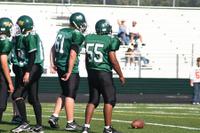My undergraduate students complete notecards the first day of class telling me about their hometowns, interests, work experiences, goals, and a description to help identify them. This year, one student wrote “I look like a pot dealer” in the description section because he had been approached twice by people looking to buy marijuana. Just to be absolutely clear, the student was not, nor had he ever been, a pot dealer. So what does a stereotypical pot dealer look like? My personal little thought bubble calls to mind somebody who looks like this and sounds like this but I’m sure there are other models.
Is this a common experience? It brought to mind my first days at college, when two instructors asked me for drugs (one of them calling me at home). Just to be absolutely clear, I was not, nor have I ever been, a pot dealer. I was really spooked both times. My reaction was probably a “lite” version of what women feel when solicited for prostitution when pushing a stroller on their way to the grocery store — fear, anger, then confusion (what could you possibly have been thinking?). Today, drug convictions can make one permanently ineligible for student financial aid in addition to serious jail or prison time. Of course, marijuana is common on campus (the prevalence rate was 76% in one of my recent upper division classes) and it wasn’t as though they asked me to be a hit man. Still, the incidents told me I was sending the wrong signals — I wanted an “A” and a letter of recommendation, not a mandatory minimum sentence. I never discussed drugs and certainly didn’t carry any signs of substance use other than bloodshot eyes from studying too late and concert t-shirts. At 18, I could have been arrested for impersonating a musician but never a drug dealer. At the time, I was trying to make friends and present myself as a bright-eyed, creative, and hardworking young hipster — I talked excitedly and goofed around in class, visiting every TA and prof in their office hours.
In retrospect, they probably didn’t approach me (or my student) because we gave off “dealer vibes” or showed signs of drug use. Instead, they probably just thought we’d be safe to ask. That is, the instructors figured I was “cool” and they could trust me not to report them as potheads to their departments or university administration. Plus, they didn’t ask whether I could sell them pot, but instead asked whether I knew where to get some. So it’s a network thing: instructors sized me up as nonconforming and trustworthy, and thought that my social networks might include people (or people who knew people) who might be in the business. Crudely put,
P(asked) = f(style cues, interpersonal trust, perceived networks)
Bruce Jacobs has some fascinating work on the “perceptual shorthand” and cues used by street dealers and undercover officers. Here’s a partial abstract from a 1996 piece on undercover high school officers (e.g., Johnny Depp in Jump Street) in Soc. Quarterly (37: 391-412):
…Officers must move from new student to peer to drug purchaser without any informant assistance and with severe time constraints. Three specific techniques are used to trigger this process: class clowning, retreatism, and troublemaking. Each is a variation on the single theme of rebellion…these techniques generate interpersonal familiarity from a distance by creating reputations that drug dealers identify with and vest legitimacy in. Reputation substitutes for introductions informants could otherwise give, establishes a pretransaction comfort zone, and lays the interpersonal groundwork officers need before they can solicit drugs. Officers’ behavior is conceptualized through the notion of a cognitive bridge, a hybrid of interactionist and microstructural principles. …
Now that’s interesting. In my early college days, I was inadvertently sending the same signals that undercover narcotics officers use to gain trust — establishing a comfort zone by clowning in a mildly rebellious way and hanging out with instructors. I still try to lay an “interpersonal groundwork” with people, but fortunately (in the drug-free workplace of today) nobody asks me to help them score weed. If they did, I’d panic — I wouldn’t even tell them about students who look like pot dealers. The last time I was approached as anything other than a professor was last year, when a Nashville boot salesman asked “are you an entertainer, son?” Now that’s what I was after all along. Too bad he probably asks it of all the tourists and conventioneers…









